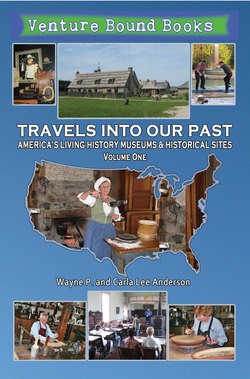Читать книгу Travels Into Our Past: America's Living History Museums & Historical Sites - Wayne P. Anderson - Страница 9
5. The Moravians Built a City Old Salem, North Carolina
ОглавлениеOn our visit to Winston-Salem, North Carolina, we concentrated our attention on the Moravians who had settled the area in stages. We went first to their original 1753 settlement Bethabara, which has a visitor center, several reconstructed buildings including the church, and ruins that have been uncovered by archeologists.
The Moravians were a group of German speaking immigrants from Moravia who broke off from the Catholic Church a hundred years before Luther and who to escape persecution came to America. Originally settling in Pennsylvania they bought a large piece of land in North Carolina and sent a team of men to settle it and prepare for the others to come.
They sent highly trained men--a blacksmith, potter, carpenter, farmer, gardener--and when they were established, the other members of the church came. The visitor center’s 15-minute film gives the background including the problems with the Native Americans in the area.
The Palisade Fort the immigrants used for protection has been reconstructed. A guide in a period costume took us through the area that has cellars reconstructed in the early 1960s by Stan South, a North Carolina state archeologist.
Most interesting to us was the church the Moravians built that also included the home of the minister, both refurnished with artifacts of the period. We were introduced to how their church services were run and how marriages were arranged. As seems to happen to us with some frequency, as we sometimes travel in the off-season, there was only one other person on the tour so we could ask lots of questions.
We were also introduced to the Moravian Medical Garden that has a variety of plants growing that were used as the pharmacy of 1761. The Moravians were obviously among the highly skilled settlers in the new world, coming prepared with the knowhow to start a successful community.
We then went to Old Salem, which is considered to be one of America’s most authentic and well-documented Colonial sites. We walked down streets with over 100 restored buildings from the era. Many of these are private homes, but sprinkled throughout are several dozen buildings staffed by costumed re-enactors giving the visitors a look into the past.
We started at the visitor center where we purchased a green card allowing us entry to the different buildings where we were met with either guides to take us through the building or artisans who could demonstrate skills of the period. Wayne was impressed with the gunsmith who was making flintlock rifles of the period which could be purchased for 2500 to 7500 dollars.
We visited the oldest standing black church in the nation where the guide pointed out this was one of the few places that blacks had an opportunity to learn to read and write. In the Vogel House, the most modern house in the area, being built in 1819 and modernized in 1840, we saw the John Vogler’s silversmith tools. One costumed artisan was demonstrating quilt making. Half a dozen gardens are spread throughout the area.
Not on the tour but within the town is the Salem Academy and College (Single Sisters’ House, 1786) one of the oldest educational institutions for women in the U.S.
